Abstract
In recent centuries, water consumption rates have more than doubled and the population growth rate is rising constantly. As a result, water scarcity is now one of the main problems to be faced, mainly in semiarid regions. In light of such a dilemma, this study aims to develop a system dynamics model in order to evaluate the water system in the semiarid region of the state of Paraíba—located in the Brazilian Northeast—and it focus on the following two issues: (1) measures that could have been taken with respect to the recent water crisis (2012–2017); (2) simulating water availability up to 2025. It was observed that, despite the options of in-demand management tools being efficient solutions for water scarcity in the short term (e.g., the influence of scarcity-based tariffs in reducing water use), such tools would not suffice in a context of severe drought within a water-providing system that depends heavily on rainfall. However, certain policies involving water-supply management (e.g., wastewater reuse and inter-basin water transfer) are very effective in maintaining water supply and avoiding a water collapse in the region. Furthermore, employing the Monte Carlo approach in simulating the system dynamic proved that the water supply is sensitive to scarcity-based tariffs, wastewater reuse, and inter-basin water transfer. An important advancement in this study was the simulation of a methodology for pricing that encourages rational use of water-based on its scarcity, which in turn increases revenue and investment in other water-management strategies.
1. Introduction
The security of potable water is a growing concern, since population growth, climate change, rapid urbanization, and increasing demands for water due to the upturn of economic growth place considerable pressure on available water resources [1]. According to WHO/UNICEF [2], more than 2.1 billion individuals do not have secure access to services providing potable water. Although water’s domestic use is not a crucial part of water consumption in the world today, it plays an essential role in everyday life and is directly linked to social well-being and public health issues. Therefore, the efficient use of domestic, limited water resources is one of the key concerns in water management.
In general, there are two distinct types of policies that water-management companies and their officials can adopt: managing water demand (such as water restriction or prices) and increasing water supply (desalination, recycling rainwater, and inter-basin water transfer). These two policies are interconnected, as more effective demand management (e.g., optimized water prices) can lead to less urgency by increasing the water supply [3]. In other words, in order to ensure water security in the long term, water concessionaires need to diversify their investments in supplying water while simultaneously improving the efficiency of water usage through implementing a range of strategies to manage demand [4].
In the semiarid region of the state of Paraíba, in the Brazilian Northeast, urban water supply systems are fueled almost entirely by surface reservoirs. In this way, supplying water depends exclusively on repositioning water stocks from the surface reservoirs during the brief rainy season, which lasts between two and four months, annually. The consequence of this type of management logic results in increasingly severe droughts. For example, the most recent drought (2012–2017) was the worst water crisis in the history of Paraíba’s semiarid region.
However, when droughts occur, the standard procedure has been a series of water restrictions, which have become even worse. In the midst of the crisis, the water restriction policies adopted by CAGEPA (Companhia de Água e Esgoto da Paraíba—the water and sewage company of Paraíba) included temporary suspension in withdrawing water for industries and irrigation purposes to even suspension policies in human supply, which climaxed at 112 h per week without water supply at the crisis peak point in 2017 [5]. According to Grafton and Ward [6], and Bakker et al. [7], these water rationing policies, including mandatory restrictions on water use, are proven to be inferior with respect to economic and social equity. Most of these policies without “prices” impose additional costs. For families, such costs can be concealed, for example, purchasing new devices and/or additional household deposits. The same applies to sanitation companies, with costs related to the monitoring and execution of services [8].
In light of the discussion above, exploring efficient alternatives for policies in water management (including strategies in water supply and demand management) has almost become a consensus among water-management officials—principally in semiarid regions where drought periods are recurrent [9]. On the other hand, the highly dynamic complexity present in these policies, when applied in urban water systems, presents great difficulties in achieving efficient urban water management. Such is a particular result of our inability to see the multiple causalities removed by time or distance. Moreover, Proust and Newell [10] reiterate that, in order to optimally manage a water system and evaluate its resilience and sustainability considering possible changes in weather, population, and standards of consumption throughout time, these systemic changes must be taken into consideration.
In this context, this study aims to develop a system dynamics (SD) model to evaluate the water system in Paraíba’s semiarid region and address the following two issues: (1) measures that could have been taken with respect to the recent water crisis (2012–2017); and (2) simulating water availability up to 2025. The developed model considers variability in demand and water supply under a variety of scenarios, taking into account population growth, strategies in managing demand (conservation and water pricing), and supply options (wastewater reuse and inter-basin water transfer). The nexus between fluctuations in water demand, water supply, water tariffs (i.e., prices) and revenue is highly complex and established by multiple interconnected factors. Thus, the system dynamics (SD) approach can be useful to evaluate this relationship, given its ability to explain the feedback and its nonlinear connections.
An important contribution of this study is the discussion and improvement, through a real case, of approaches to model urban water balances that incorporate economic feedback through new water-pricing methodologies, which in turn, can increase revenue and investment in other alternatives of water-management instruments (see 2.2 for further elaboration). Included in this study are data on water-supply sources, water-demand sources, tariff values, revenue, water loss, and wastewater reuse. This paper defines a case study, describes the SD Model for urban-water management, discusses the model results, and presents the findings.
2. Materials and Methods
2.1. Case Study
The Epitácio Pessoa Reservoir (Figure 1), which has a considerable storage capacity of 411 MCM (million cubic meters) [11], currently supplies water to the city of Campina Grande and 18 other small municipalities located across the semiarid region of Paraíba. The population of the region under study consists of approximately 650,000 people with a current and future growth rate of 1%, which was taken into consideration [12].
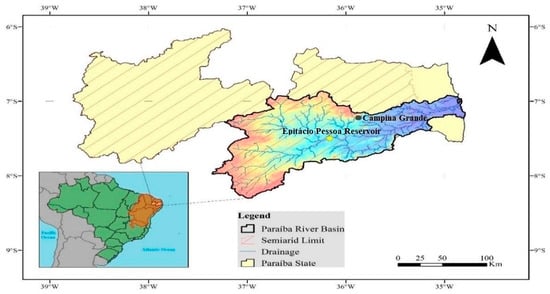
Figure 1.
Location map of the Epitácio Pessoa Reservoir River Basin in Brazil.
The cities receiving their water supply from this reservoir face an array of challenges, occurring principally due to hydroclimatic aspects in the Paraíba River region—the main source of the reservoir (Table 1) [13,14]—as well as factors linked to municipal water management (e.g., the high rate of 33% water loss) [15]. The water loss considered in this study was a result of real losses (leaks in pipes) and apparent losses (theft, and hydrometers with calibration problems). Another worrying factor was the high average of water consumption that corresponded to approximately 222 L/p/d (liters per person per day) (131 domestic + 91 industrial/other) [16,17], although this index was considerably lower than most industrialized countries [18].

Table 1.
Aspects of the Paraíba River region.
Information concerning inflow and evaporation flux of the Epitácio Pessoa Reservoir, which complements the water balance needed to realize the simulations in this study, was acquired from Nunes et al. [14]. Therefore, for inflow, a series of discharges between 2004 and 2015 was employed based on daily volume measurements (Figure 2).
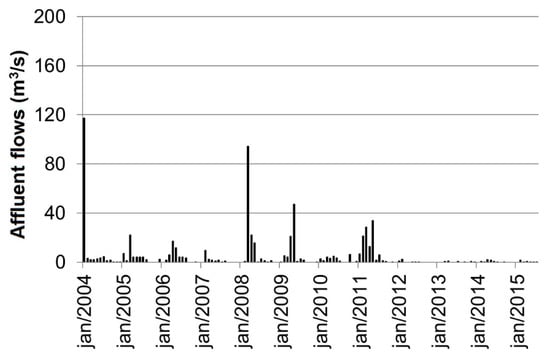
Figure 2.
Historical series of inflow discharge to the Epitácio Pessoa Reservoir (2004–2015).
With respect to evaporation, measurement of evaporated water sheets in the Epitácio Pessoa Reservoir was non-existent. For this very reason, the mean data of monthly evaporation in a Class A evaporimetric tank were used, collected in the basin at São João do Cariri School from the Federal University of Campina Grande (UFCG). The series was considered representative due to its proximity to the reservoir, similar weather characteristics, vegetation, and terrain. Coefficients (Kp) calculated by Nunes et al. [14] were used to correct the measured values in the Class A tank. In the Epiácio Pessoa Reservoir, coefficients other than the commonly employed value of 0.7 were used seasonally, given that each season of the year brings its own climatic conditions, radiation, humidity, wind, and air temperature, among other attributes associated to the exclusive climate of each locality. The monthly averages of evaporated water sheets used in the simulations can be observed in Figure 3.
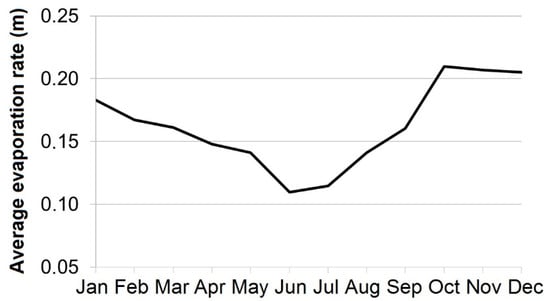
Figure 3.
Average monthly evaporation.
Between 2012 and 2017, the Epitácio Pessoa Reservoir faced its worst water crisis since its construction, with recorded rainfall volumes below the historical average. In April 2017, the reservoir reached its lowest stored level of only 14.79 MCM of water, equivalent to 3.2% of its total inventory capacity. In the midst of this catastrophe, the reservoir received potable water on an emergency and provisional basis from the São Francisco River Integration Project (PISF), and is ensuring water supply in the region to the present day—despite low levels of water stocks that are already worrying reservoir managers caused by the routine suspension of water transfers as a result of canal maintenance.
The Epitácio Pessoa Reservoir provides water for multiple uses (urban, agricultural and industrial consumption); however, for the purposes of this research, the scarcity price adjustment proposal was restricted only to domestic use. Table 2 presents an example of CAGEPA’s price policy for residential consumption based on increasing block tariffs (IBT) model in 2017.

Table 2.
Water prices for residential consumption in Campina Grande (2017).
The first block (consumption ≤ 10 m3) of this tariff had two objectives: to achieve equity in access to water and to establish a minimum price that corresponded to the economic and financial sustainability of the provider responsible for the water service. If the residence exceeded 10 m3 of water consumption, for example, 12 m3, the tariff calculation was (11.16 + 2 × 1.44). This same logic applied to other consumption blocks. Figure 4 shows the distribution of households per block of water tariff. It is verified that 57.9% of the households were in the consumption block of 0 to 10 m3 and 31.6% in the block between 10 and 20 m3, which made up a total of 89.5% of the households only in these first two blocks [19].
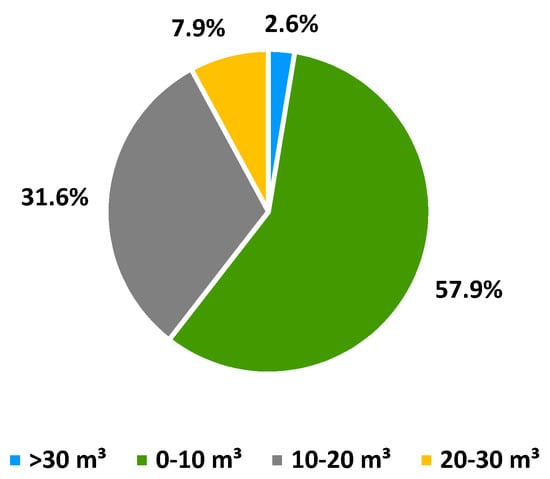
Figure 4.
Percentage of households per block tariff.
It ought to be reiterated that the adjustment model proposed in this study was not considered for the minimum consumption tariff of up to 10 m3 since this tariff played a role of equity in accessing water. In this way, the adjustment applied to subsequent consumption bands, penalized larger water consumers. The value of the tariff used in the model was the result of an average value of all the bands above the minimum tariff, collected from the SNIS website [15].
2.2. Scarcity-Based Tariff
In most countries water is considered an abundant good, however, with the impacts of climate change, rapid urbanization, and consequently increasing demands at a low price, water’s categorization has gone from “free good” to “scarce good”. This problem is aggravated by multiple types of users (population, animal, irrigation, industries, fishing, etc.) with conflicting interests [5]. In this context, the importance of employing economic instruments—specifically tariffs—was incorporated, which aimed to signal the scarcity of water resources by allocating a price so as to induce rational use [20,21]. Thus, the water tariff took several different forms [22].
In this study, a model of price adjustment known as “scarcity-based tariff” (SBT) was presented. This price was based on water supply systems that depend on natural resources influenced by the climate [23]. When water becomes scarce, its marginal value grows and the scarcity price aims to reflect this. From an economic point of view, as the supply of water becomes abundant, this value drops to almost zero, and the price of water paid by families only reflects treatment and delivery expenses [24].
In the context of regions suffering from constant periods of water stress, as is the case of the semiarid region of Paraíba, the use of scarcity-oriented prices can be a highly effective way of correctly pricing water use while also maintaining a role of equity in access to water. Hence, this type of price adjustment ensures two fundamental objectives for water suppliers in periods of scarcity: it encourages demand reduction by increasing water prices, and, at the same time, allows users to choose to use water-based on opportunity cost [25].
According to the SBT applied in this study, prices were determined from the reservoir’s water availability, in which the price could reach a maximum percentage of up to 200% in relation the regular tariff in its “dead” volume (that is, 10% of the maximum capacity of the reservoir, a level that represented water insecurity for the cities that were supplied by the Epitácio Pessoa Reservoir) [26]. Similarly, as the total storage levels were restored due to above-average rainfall or loss control, the SBT levy was withdrawn at the same trigger points. To predict the extent of the consumer’s response to a price change, the following basic demand elasticity equation was consulted (1):
where,
WDpc: water demand per capita;
AP: adjusted price;
RT: regular tariff;
: price elasticity of demand.
In this research, a system dynamics model (SDM) was constructed using this information to provide a robust platform for demonstrating interactions, including new elements that encourage demand reduction and generate revenue responses associated with price adjustments.
2.3. System Dynamics
The SD approach describes the behavior of complex systems over time through internal feedback cycles and delays that affect the behavior of the system as a whole [27]. Created by Jay Forrester in the 1960s and propagated by the Club of Rome’s limits to growth in the early 1970s [28], the SD approach has been applied in several areas such as urban transportation [29,30], health [31,32,33], economy [34,35], and natural resources [36,37,38].
In the planning of water resources in urban areas, some studies were observed in the literature using the SD approach. Susnik et al. [39], developed an SD Model to assess water scarcity and the possible impacts of socioeconomic policies on a complex hydrological system (involving numerous sources of capture and demand from four sectors: domestic, industrial, agricultural, and external pumping). The model was applied to the Merguellil catchment region of water scarcity in Tunisia. Still, in this context, Dai et al. [40] produced an object-oriented system dynamics model to capture the interrelationships between water availability and increased water demand for the industrial growth and consumption of the population located in the Manas River Basin, the region of Xinjiang Uygur. Dawadi and Ahmadi [41] investigated the influence of population increase and the effect of climate change on water availability of the semiarid Las Vegas Valley in southern Nevada.
In Sahin’s studies [25,42], urban water management models were developed applying the SD approach. The studies aimed to create price adjustments, which could, in turn, generate revenue to invest in desalination plants capable of providing water security in an efficient way in the future. The study was developed in Queensland, Australia. Huanhuan et al. [43] used SD to analyze the future water availability of a coastal region in Longkou, Shandong Province, China. For this study, four different scenarios (business as usual, economic development, and comprehensive water resource protection) were designed for 50 years. Weil et al. [44] constructed a model of urban water management, which incorporated the will to conserve—and according to the model—residents’ water resources and the effects of water-saving were quantified.
In their study, Ahmadi and Zargham [45] addressed water consumption in urban green spaces for the city of Shiraz, Iran, and the main question was whether one should seek external water resources (dam construction) or resources within the city (sewage treatment). For this purpose, a system dynamics model was developed to evaluate and compare different scenarios of external and internal water supply through to 2025.
Thus, the interconnected components and complex behavior of the system for urban water systems can be acknowledged with the SD method [46].
3. Development of a System Dynamics Model
3.1. Causal Loop Diagram for the Water in the Semiarid Region of Paraíba (WSPB)-SD Model
In this study, a causal loop diagram was created to capture the interactions between population growth, water investment, domestic water demand, agriculture water demand, industrial water demand, surface water supply, and water policy options considering supply and demand management to the “Water in the Semiarid Region of Paraíba” SD Model (WSPB-SD), as shown in Figure 5. The model was developed using the Vensim DSS v6.3 software package [47].

Figure 5.
Causal loop diagram for the water in the semiarid region of Paraíba (WSPB)-system dynamics (SD) Model.
3.2. Stock and Flow Diagram of WSPB-SD Model
After building the causal loop diagram, the sub-models were delimited to construct the stock and flow diagram (Figure 6). The proposed diagram consisted of five sub-models: population sub-model, water supply (surface) sub-model, demand sub-model, water tariff sub-model, and reclaimed water sub-model. To avoid anomalies due to oscillations in reservoir levels, the model was designed to aggregate the monthly output on an annual simulation step.
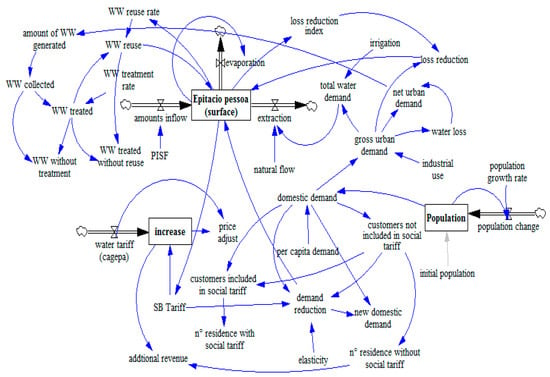
Figure 6.
Stock and flow diagram of the WSPB-SD Model.
3.2.1. Population Sub-Model
The population is one of the main consumers of water in relation to its multiple uses. It ought to be emphasized that the population’s domestic consumption includes both urban and rural users. The population level was calculated using the current population and population change, as shown in Equation (2).
where,
P—population;
—population change rate (person/year);
—initial population.
One of the main causes of low population growth in the semiarid region considered in this study was water scarcity, bringing about consequences both for the population’s well-being and for the region’s economy, which in turn incentivized migration to large capitals in search of better living conditions.
3.2.2. Water Supply Sub-Model
The Epitácio Pessoa Reservoir is a stock of surface water, being the only supply source for the region delimited in this study. Equation (3) shows the formulation of the water balance adapted to the Epitácio Pessoa Reservoir [14]. All variables were measured using MCM (million cubic meters).
where,
t—present simulation interval and t + 1 is the next simulation interval;
St—volume stored in the reservoir;
VDt—volume discharge to the reservoir;
Et—water volume lost by evaporation;
VWt—volume withdrawn from the reservoir for consumption;
NFt—volume of water spilled from the reservoir to natural flows in the Paraíba River.
It is important to reiterate that, in order to simulate future scenarios (2016–2025), the same series of observed, meteorological data were repeated during future periods of time to consider a variety of inflow discharges to the reservoir.
3.2.3. Water Demand Sub-Model
Total water demand was calculated from the actual use of water resources (available in Table 3). Thus, the following variables were related to the demand for water resources: domestic water consumption, industrial water consumption, and withdrawals for irrigation. The annual domestic water demand was calculated using the following Equation (4):
where,

Table 3.
Predefined input parameters for examined simulation scenarios.
DWD—represents the annual domestic water demand;
P—annual population;
WDpc—water demand per capita.
Once the domestic water demand was calculated, it was then possible to determine the total demand for water using Equation (5):
where,
TWD—annual total water demand;
DWD—domestic water demand;
IWD—industrial water demand;
AWD—agriculture water demand.
3.2.4. Water Tariff Sub-Model
The equation that defines the adjustment price is shown in Equation (6).
where,
AP—adjusted price;
RT—regular tariff (CAGEPA);
SBT—scarcity-based tariff (percentage increase over the regular tariff).
The elasticities used to evaluate the users’ sensitivity to the new price levels were 0.45 and 0.55, proposed by Medeiros and Ribeiro [48] and Bank of Northeast Brazil [49], respectively.
3.2.5. Returned Water Sub-Model
In this sub-model, returned water with loss control and wastewater reuse were both considered as the total volume of water that was returned the system. Returned wastewater was geared toward irrigation. The total volume of water going back into the system was calculated using Equation (7).
where,
RW—annual returned water;
LC—returned water with loss control;
WW—returned water with wastewater reuse.
3.3. Model Validation
Before proceeding with the analysis of the results, the model was validated for water balance from 2005 to 2015. Thus, direct structural tests evaluated the validity of the model structure against the real system. For this purpose, we checked whether the model included all critical variables that were to be investigated.
In addition, the model’s performance was evaluated using the mean absolute percentage errors (MAPE), in which a 2.8% error was observed between the simulated data and the real data. The results, therefore, indicated satisfactory model performance; that is, the estimated model represented well the actual behavior of the reservoir (Figure 7). The validated model was used to generate the water balance for the future from 2016 to 2025.
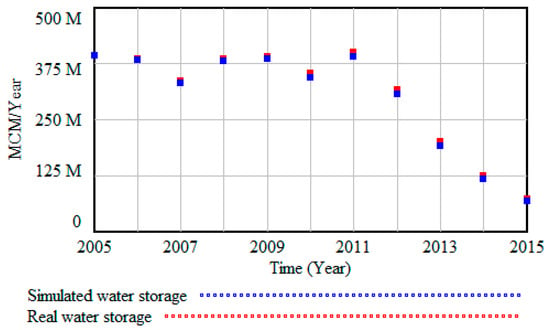
Figure 7.
Comparison between real and simulated water storage in the Epitácio Pessoa Reservoir.
3.4. Scenarios
In this research, six scenarios were simulated alongside the status quo scenario to identify water policy options considering supply and demand management (Table 3). Exploring these scenarios using the SD Model can put water sector managers in a better position to understand the complexity and dynamic aspects of the system, supporting them to manage and make decisions more effectively.
4. Simulation Results
4.1. Status Quo Versus Scenario 1
In this scenario (Figure 8), a comparison of Status Quo versus Scenario 1 was carried out. The Status Quo Scenario represents the simulation made for the real scenario of the phenomenon studied. This scenario was characterized by a series of severe water restrictions that CAGEPA imposed over an extended period of time.
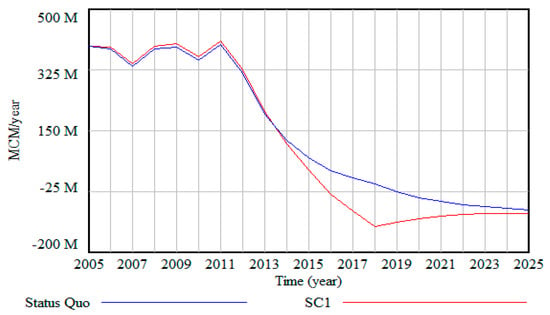
Figure 8.
Comparison between the status quo scenario and the scenario without restrictions.
In accordance with the simulations that were undertaken in this study and carried out in a real-time scenario via restriction measures, the water supply was able to be guaranteed until April 2017 with a volume of approximately 13.7 MCM (3%). It was at this point that the reservoir received water from the São Francisco River Integration Project (PISF). As can be observed in Figure 8, from 2017 onwards, such measures would no longer be efficient, and would, in fact, cause a water deficit of more than 70 MCM by the conclusion of the simulation period. It is noteworthy that this scenario disregarded water entering the reservoir from the PISF.
For Scenario 1, assuming no changes in the current patterns of urban water use and irrigation during the simulation period, the municipalities supplied by this water-producing system would run out of water in early 2016, consequently accumulating a water deficit of more than 120 MCM by the end of 2018. This deficit would be reduced to 86 MCM in 2025. The water consumption considered for this scenario was that adopted by CAGEPA in the periods when the reservoir was at safe levels for supply (131 domestic + 91 industrial/other = 222 L/p/d).
4.2. Impacts of the Scarcity-Based Tariff on Water Conservation—(SC2)
For this scenario (Figure 9), the influence of SBT on the water storage level during the simulated period was analyzed. Therefore, in accordance with the simulations, it can be concluded that the SBT was an efficient strategy to incentivize reductions in water demand; however, with respect to the case under study, such a strategy would not be capable of avoiding a water collapse in the region, but rather a significant water-deficit reduction by the conclusion of the simulation period. For example, in 2022 the water deficit would be at 20 MCM, falling even more to 11 MCM in 2025. Concerning Scenario 1, such represents a reduction percentage of 78% in 2022 and 86% in 2025.
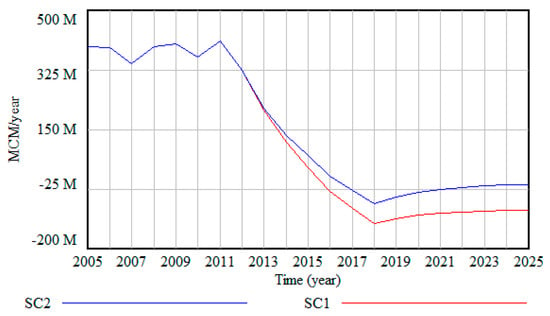
Figure 9.
Impacts of the scarcity-based tariff on water conservation.
Another positive aspect of the scarcity price strategy through SBT is the generation of additional revenue that can be added to CAGEPA’s regular income and can be useful for looking further into other water-management policies that require a high level of investment (e.g., capital cost for investing in loss control, transfer, and wastewater reuse). It was verified that after the SBT was activated (2013), extra revenue of approximately $97 million was generated by the end of the simulation period, without considering revenue with the regular tariff.
4.3. Impacts of Loss Control on Water Conservation—(SC3)
This scenario simulated the impact of a loss-reduction policy on water availability without restricting water consumption. As mentioned before, in this research, the term “water loss” included both real and apparent losses. Statistical of water loss in the region under examination was around 33%. Three scenarios were proposed with loss-reduction indications of 15%, 20%, and 25% for an estimated value of $38 million, $40 million, and $42 million respectively.
As Figure 10 shows, with the implementation of a loss-reduction policy early in the drought, a water collapse in the region would only be delayed briefly (in Scenario 1), reducing the water deficit in all scenarios of loss control throughout the simulation period. For example, for 15% efficiency in loss reduction (from the current rate of 33%), the water deficit would be reduced to 68 MCM in 2022 and 62 MCM in 2025. With respect to Scenario 1, such represents a water-deficit reduction percentage of 25% in 2022 and 31% in 2025. With 20% efficiency, the water deficit would be reduced to 60 MCM (34% reduction) in 2022 and 54 MCM (37% reduction) in 2025. In a situation rendering 25% loss (from the current rate of 33%), the water deficit would be reduced to 52 MCM in 2022 and 47 MCM in 2025. In regards to Scenario 1, these conditions would result in a water-deficit reduction percentage of 42% in 2022 and 45% in 2025. Nevertheless, it is certain that no matter how efficient the loss control in water-distribution networks could becomes, for a drought period of more than six years, such policy would not impede a water collapse in the region.
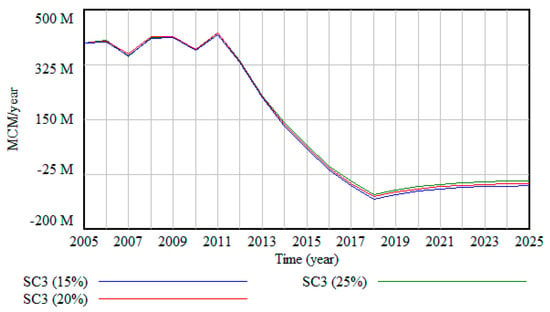
Figure 10.
Impacts of loss control on water conservation.
4.4. Impacts of Wastewater Reuse on Water Supply—(SC4)
Among the entire region under study, the city of Campina Grande comprised a significant portion of water consumption in this study, and possessed a good index of sewage collection; yet, only 5% of this amount was treated [50], not to mention the dearth of policies governing wastewater reuse in the region. In this vein, this study’s proposed scenarios included indicators of wastewater reuse in amounts of 60%, 80%, and, more optimistically, 100%. All wastewater treated and reused was directed toward irrigation, thus reducing water scarcity for other purposes.
Analyzing Figure 11, it can be verified that, despite water reuse not avoiding a water collapse, the water deficit was reduced considerably. For example, in Scenario 1, absent of water-management policies, the water deficit became 92 MCM in 2022 and 87 MCM in 2025. In a scenario with 80% wastewater reuse, this deficit dropped to 24 MCM in 2022 and 17 MCM in 2025, representing a water-deficit reduction percentage of 73% in 2022 and 80% in 2025. For the most optimistic situation, the deficit was significantly reduced to 8 MCM (91% reduction) in 2022 and less than one MCM (100% reduction) in 2025.
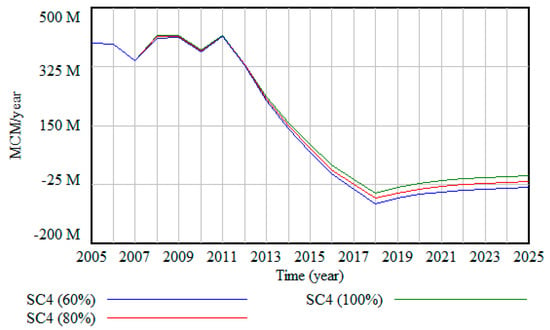
Figure 11.
Impacts of wastewater reuse on water supply.
4.5. Impacts of Inter-Basin Water Transfer on Water Supply—(SC5)
In this scenario, the São Francisco River Integration Project (PISF) was taken into consideration. PISF is a hydra-infrastructure project divided in two canals (the north canal and the east canal) that captures water in the São Francisco River with the objective of ensuring water security through the integration of hydrographic basins in the semiarid region of the Brazilian Northeast—a region that suffers from water scarcity and irregular rain patterns. It was estimated that the flow directed to this region averaged at 10 m3/s [51]. Despite the fact that PISF was in its final phase of construction, its eastern connection point already transfers water temporarily to Paraíba’s semiarid region through the east canal. Yet, from the initial phase of the project in 2005 up until the present day, PISF has incited disagreement from the interested parties originally from the São Francisco River Basin and the project’s beneficiaries alike. Specialists and experts have also debated about possible solutions for water supply at lower costs, since the budget of the final project was set to around $3 billion with the project’s state beneficiaries fronting these costs. This is in addition to projections resulting from impacts of climate change, which will certainly be influential in ever-longer periods of drought in the Brazilian Northeast, therefore decreasing the availability of water flowing from the São Francisco River Basin, according to De Jong et al. [52].
In scenarios with PISF implementation, two assumptions were made. The first being that the study simulated the scenarios with the increment of water from PISF starting from 2015. The second referred to the flows that were considered in the two scenarios, which were 2 m3/s and 4 m3/s. Such flows were admitted due to the fact that, before the water arrived to supply the Epitácio Pessoa Reservoir, it underwent a 220-km journey. In this sense, specialists affirmed that during that journey, the PISF supplied many reservoirs, occurrences of water theft by communities residing along the canal, in addition to possible water-supply interruptions for reasons of maintenance. Under such conditions, the amount of water that arrived successfully to the Epitácio Pessoa Reservoir was less than half that estimated by PISF. The simulated scenarios are presented in Figure 12.
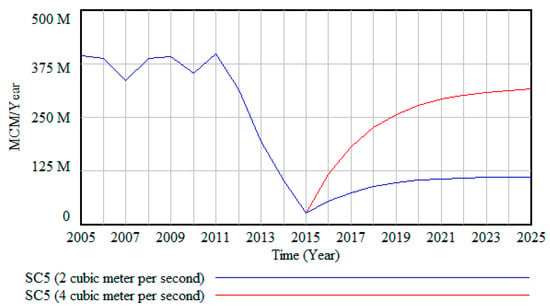
Figure 12.
Impacts of inter-basin water transfer on water supply.
In accordance with the simulated scenarios of both flows (2 m3/s and 4 m3/s) supplied by PISF, a water collapse would be avoided in the region. In addition, the reservoir would reach to the end of the simulation period with high stocks of water and no risk of water scarcity, as is verified in Figure 10.
4.6. Combining the Impacts of Wastewater Reuse and Scarcity-Based Tariffs on Conservation and Water Supply—(SC6)
In this scenario, the impacts of water conservation through the SBT increment and wastewater reuse for purposes of irrigation were aggregated. The SBT was simulated considering three scenarios of reuse (60%, 80%, and 100%). In accordance with Figure 13, it is to be noted that, with the implementation of these two policies (demand management and supply), it was possible to reduce water scarcity during an analyzed drought period and maintain relatively high water stocks in the reservoir through the conclusion of the simulation period in all scenarios.
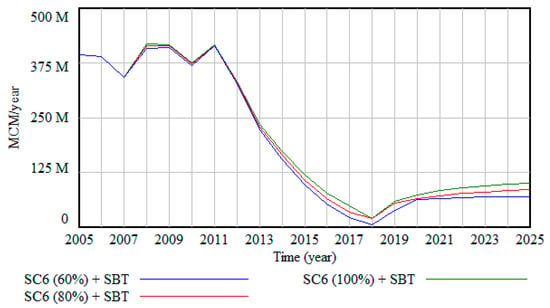
Figure 13.
Impacts of wastewater reuse and the scarcity-based tariff on conservation and water supply.
In the scenario of 60% wastewater reuse, the reservoir’s water supply would be 67 MCM in 2022 and 69 MCM in 2025. In the scenario of 80% reuse, water supply would reach 76 MCM in 2022 and 84 MCM in 2025. Finally, for the most optimistic case of 100% reuse, water stock would cap at 90 MCM in 2022 and 102 MCM in 2025. It is noteworthy that in this scenario there was no need to implement water restrictions during the water-crisis period.
In general, it thus becomes clear that a paradigm shift from this conventional utility planning approach to a price and investment response mechanism (here, SBT) promotes proactive decision-making and more efficient investment in water supply management options. Specifically, this market-oriented approach could provide long-term price stability, increased self-funding, and reductions in requirements for severe restrictions.
5. Uncertainty Simulation by Monte Carlo Simulation
In this section, a sensitivity analysis of the results was carried out for each simulated scenario. The analysis objective was to identify the parameters that most prominently impacted water availability in the WSPB model. To that end, six variables were selected: loss control coefficient, scarcity-based tariff, wastewater reuse rate, population increase rate, domestic demand per capita, and the average rate of inter-basin water transfer. All of these parameters possessed uncertainties, and therefore significantly affected the WSPB model (Table 4). The Monte Carlo simulation was the method used for this evaluation.

Table 4.
Parameters used in the sensitivity analysis.
Figure 14 presents the results of the sensitivity analysis. It is important to understand that in this figure, the colors yellow, green, blue, and gray represent trust limits of 50%, 75%, 95%, and 100% respectively. Furthermore, if the parameter provides a graph with a wider band, such demonstrates that the parameter is more sensitive to the WSPB model. In this sense, observing Figure 14, one can verify that the SBT (14b), with an initial value of 1 and interval (1, 3) is a parameter that possesses significant impacts on the WSPB model. Another parameter in which the WSPB model is strongly sensitive is the wastewater reuse rate (14c). Given that the initial value is 0.6 and the test-sensitive interval is [0.1, 1], one can deduce that the wastewater reuse rate will have an apparent impact on the WSPB model. The transfer of wastewater (14f) can be confirmed as the most influential parameter of the WSPB model, that is, based on the analysis results of uncertainty, the WSPB model is highly sensitive to the rate of inter-basin water transfer.
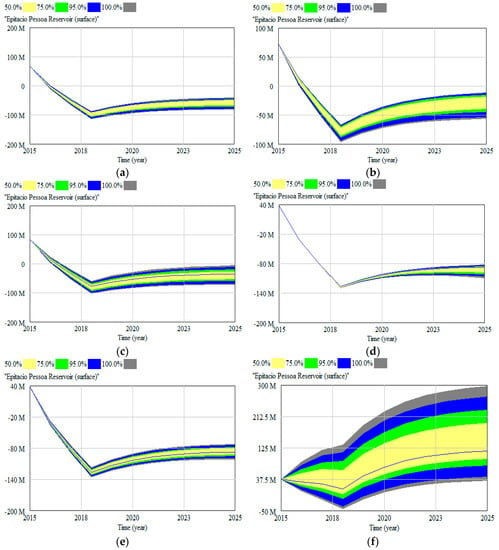
Figure 14.
Monte Carlo simulation results: (a) loss control coefficient, (b) scarcity-based tariff, (c) wastewater reuse rate, (d) population growth rate, (e) domestic demand per capita, (f) inter-basin water transfer rate.
On the other hand, the loss control coefficient and the demand rate parameters exercised little influence on the WSPB model, as is shown in Figure 14a,e. The loss control coefficient had an initial value of 0.25 and a test-sensitive interval of [0.01, 0.3]. The initial value for the demand rate was 48m3 with a test-sensitive interval of (40, 55). Finally, the WSPB model was minutely sensitive to the population growth rate (Figure 14d) with an estimated initial value of 0.1 and a test-sensitive interval of [0.001, 0.4].
6. Conclusions
In this study, a system dynamics model was developed to investigate the complex interactions in a water-supply system in the semiarid region of Paraíba, in the Brazilian Northeast—which possesses scarce water resource options. In accordance with the simulated results, if no type of water-management policy is implemented, the region will suffer a water collapse in the near future. It is worth noting that the region did not lack water definitively at the beginning of 2016, due to a series of severe water restrictions in residential areas and temporary supply suspensions in industries and irrigation. Therefore, the need to implement water-management and demand policies has now become a consensus among water sector managers in the region.
In accordance with the simulated results of six scenarios proposing water-management policies, it was observed that in spite of the options of in-demand management tools being efficient solutions for water scarcity in the short term (e.g., the influence of scarcity-based tariffs in reducing water use), such tools would not suffice in a context of severe drought in a water-providing system that depends heavily on rainfall. On the other hand, certain policies involving water-supply management (e.g., wastewater reuse and inter-basin water transfer) are very effective in maintaining water supply and avoiding a water collapse in the region—especially in a context of combining wastewater reuse and scarcity-based tariffs.
With respect to water-supply policies that take into account inter-basin water transfer (PISF), despite total water security through the conclusion of the simulation period, such policies have incited disagreement from the interested parties originally from the São Francisco River Basin and the project’s beneficiaries alike. Specialists and experts also debate about possible solutions for water supply at lower costs, since the budget of the final project was set to around $3 billion with the project’s state beneficiaries fronting these costs—reflecting exorbitant rises in water tariffs.
The sensitivity analysis was important in identifying the variables to which the WSPB was most sensitive. The results reinforce the findings of the scenario simulations, considering the water supply and demand management options, indicating that the variables that most impact the model were the wastewater reuse rate, scarcity-based tariff, and inter-basin water transfer. Therefore, planning to increase the efficiency and supply of these options plays an important role in water security in Paraíba’s semiarid region.
Although not being the focus of this work, it is important to highlight the existence of important environmental impacts caused by water supply policies (desalination, inter-basin water transfer, etc.), which in most cases is an obstacle to their implementation. In this study, for example, the impacts of the transposition of the São Francisco River include deforestation, desertification, loss of biodiversity, and the water imbalance of the São Francisco River Basin.
An important contribution in this study was the simulation of a water-pricing methodology that encourages rational water use based on its scarcity, which in turn increases revenue and investment in other water-management strategies.
Although the study focused on the semiarid region of the Brazilian Northeast, demand-management policies used in the study can be considered effective for other arid and semiarid regions to mitigate the effects of the imbalance between water supply and demand. Using big data in managing water resources is recommended for future studies, for the sake of offering more accurate and reasonable data to fill in and execute a system dynamics model.
Author Contributions
Conceptualization, W.C.d.A., K.P.O.E. and O.S.; methodology, W.C.d.A., K.P.O.E. and O.S.; supervision, K.P.O.E. and O.S.; validation, W.C.d.A., K.P.O.E. and O.S.; writing—original draft, W.C.d.A.; writing—review and editing, W.C.d.A., K.P.O.E. and O.S.
Funding
This research received no external funding.
Acknowledgments
We acknowledge the researchers of GAMMA—Growing with Applied Modeling and Multivariate Analysis Research Group for fruitful discussions, FAPESB—Foundation for Research Support of Bahia State and to Professor Carlos Galvão for the information provided.
Conflicts of Interest
The authors declare no conflict of interest.
References
- Romano, G.; Salvati, N.; Guerrini, A. An Empirical Analysis of the Determinants of Water Demand in Italy. J. Clean. Prod. 2017, 130, 74–81. [Google Scholar] [CrossRef]
- WHO/UNICEF. Progress on Drinking Water, Sanitation and Hygiene. Update. In Joint Monitoring Program for Water Supply, Sanitation and Hygiene (JMP); WHO/UNICEF: New York, NY, USA; Geneva, Switzerland, 2007; pp. 1–66. [Google Scholar]
- Grafton, R.Q.; Chu, L.; Kompas, T. Optimal water tariffs and supply augmentation for cost-of-service regulated water utilities. Util. Policy 2015, 34, 54–62. [Google Scholar] [CrossRef]
- Sahin, O.; Bertone, E.; Beal, C.D.A. Systems approach for assessing water conservation potential through demand-based water tariffs. J. Clean. Prod. 2017, 148, 773–784. [Google Scholar] [CrossRef]
- Lucena, D.P.M.M. Simulations of the Implantation of management actions in Epitácio People and their impacts in the water crisis in Campina Grande-Pb and Region; M.S.c Postgraduate Program in Civil and Environmental Engineering, Center for Technology and Natural Resources, Federal University Campina Grande: Campina Grande, Brazil, 2018. [Google Scholar]
- Grafton, R.Q.; Ward, M.B. Prices versus rationing: Marshallian surplus and mandatory water restrictions. Econ. Rec. 2008, 84, 57–65. [Google Scholar] [CrossRef]
- Bakker, K. Neoliberalizing nature? Market environmentalism in water supply in England and Wales. Ann. Assoc. Am. Geogr. 2005, 95, 542–565. [Google Scholar] [CrossRef]
- Vairavamoorthy, K.; Gorantiwar, S.; Pathirana, A. Managing urban water supplies in developing countries e climate change and water scarcity scenarios. Phys. Chem. Earth Parts A/B/C 2008, 33, 330–339. [Google Scholar] [CrossRef]
- Baños, C.J.; Hernández, M.; Rico, A.M.; Olcina, J.O. The Hydrosocial Cycle in Coastal Tourist Destinations in Alicante, Spain: Increasing Resilience to Drought. Sustainability 2019, 11, 4494. [Google Scholar] [CrossRef]
- Proust, K.; Newell, B. Catchment and Community: Towards a Management-Focused Dynamical Study of the ACT Water. 2006. Available online: http://www.water.anu.edu.au/pdf/publications/Catchment%20and%20Community.pdf. (accessed on 23 September 2019).
- Agência Nacional das Águas (ANA). Reservoir Monitoring System. Available online: http://sar.ana.gov.br/ (accessed on 14 December 2018).
- Instituto Brasileiro de Geografia e Estatística (IBGE). Population Estimates. Available online: https://www.ibge.gov.br/estatisticas/sociais/populacao.html (accessed on 22 January 2019).
- Vieira, Z.M.C.L. Methodology of Conflict Analysis in the Implementation of Water Demand Management Measures. Ph.D. Thesis, Postgraduate Program in Natural Resources, Federal University Campina Grande, Campina Grande, Brazil, 2008. [Google Scholar]
- Nunes, T.H.C.; Galvão, C.O.; Rego, J.C. Rule curve for seasonal increasing of water concessions in reservoirs with low regularized discharges. Braz. Water Res. J. 2016, 21, 493–501. [Google Scholar] [CrossRef][Green Version]
- Sistema Nacional de Informações sobre Saneamento (SNIS). Electronic Portal. Brasília. Available online: http://www.snis.gov.br (accessed on 9 January 2019).
- Rêgo, J.C.; Galvão, C.O.; Ribeiro, M.M.R.; Albuquerque, J.P.T.; Nunes, T.H.C. The crisis of the large campina supply: Actions of the managers, users, public power, press and population. In Proceedings of the XXI Brazilian Symposium on Water Resources, Water Security and Sustainable Development: Challenges of Knowledge and Management, Brasília, Brazil, 22–27 November 2015. [Google Scholar]
- Rêgo, J.C.; Galvão, C.O.; Ribeiro, M.M.R.; Albuquerque, J.P.T.; Nunes, T.H.C. New considerations on the management of the water resources of the Epitácio Pessoa dam—The drought 2012–2014. In Proceedings of the XII Brazilian Symposium on Water Resources, Water and Development, Natal, Brazil, 4–7 November 2014. [Google Scholar]
- Katz, D. Water use and economic growth: Reconsidering the Environmental Kuznets Curve relationship. J. Clean. Prod. 2015, 88, 205–213. [Google Scholar] [CrossRef]
- Oliveira, G.C.S.; Curi, R.C. Analysis on Water Collection in the Municipality of Campina Grande—PB. In Proceedings of the Anais III International Workshop on Water in the Brazilian Semi-Arid, Campina Grande, Brazil, 4–6 October 2017. [Google Scholar]
- Marzano, R.; Rougé, C.; Garrone, P.; Grilli, L.; Harou, J.J.; Pulido-Velazquez, M. Determinants of the price response to residential water tariffs: Meta-analysis and beyond. Environ. Model. Softw. 2018, 101, 236–248. [Google Scholar] [CrossRef]
- Rico, A.; Olcina, J.; Baños, C.; Garcia, X.; Sauri, D. Declining water consumption in the hotel industry of mass tourism resorts: Contrasting evidence for Benidorm, Spain. Curr. Issues Tour. 2019, 1–14. [Google Scholar] [CrossRef]
- Dinar, A.; Pochat, V.; Albiac-Murillo, J. Introduction. In Water Pricing Experiences and Innovations; Dinar, A., Pochat, V., Albiac-Murillo, J., Eds.; Springer: Cham, Switzerland, 2015; pp. 1–12. [Google Scholar]
- Lopez-Nicolas, A.; Pulido-Velazquez, M.; Rouge, C.; Harou, J.J.; Escriva-Bou, A. Design and assessment of an efficient and equitable dynamic urban water tariff. Application to the city of Valencia, Spain. Environ. Model. Softw. 2018, 101, 137–145. [Google Scholar] [CrossRef]
- Pulido-Velazquez, M.; Alvarez-Mendiola, E.; Andreu, J. Design of efficient water pricing policies integrating basinwide resource opportunity costs. J. Water Resour. Plan. Manag. 2013, 139, 583–592. [Google Scholar] [CrossRef]
- Sahin, O.; Stewart, R.A.; Porter, G. Water security through scarcity pricing and reverse osmosis: A system dynamics approach. J. Clean. Prod. 2014, 88, 160–171. [Google Scholar] [CrossRef]
- Agência Nacional das Águas (ANA). Information Note nº 11/2017/COMAR/SER. 2017. Available online: https://www.ana.gov.br/regulacao/resolucoes-e-normativos/regras-especiais-de-uso-da-agua/marcos-regulatorios/nt_11_2017_comar_sre.pdf (accessed on 16 February 2019).
- Sterman, J.D. Business Dynamics: Systems Thinking and Modeling for a Complex World; Irwin/McGraw-Hill: Boston, MA, USA, 2000. [Google Scholar]
- Meadows, D.H.; Meadows, D.L.; Randers, J.; Behrens, W.W., III. The Limits to Growth: A Report for the Club of Rome’s Project on the Predicament of Mankind; Universe Books: New York, NY, USA, 1972. [Google Scholar]
- Barisa, A.; Rosa, M. A system dynamics model for CO2 emission mitigation policy design in road transport sector. Energy Procedia 2018, 147, 419–427. [Google Scholar] [CrossRef]
- Fontoura, W.B.; Chaves, G.D.L.D.; Ribeiro, G.M. The Brazilian urban mobility policy: The impact in São Paulo transport system using system dynamics. Transp. Policy 2019, 73, 51–61. [Google Scholar] [CrossRef]
- Newell, B.; Siri, J. A role for low-order system dynamics models in urban health policy making. Environ. Int. 2016, 95, 93–97. [Google Scholar] [CrossRef]
- Hill, A.; Camacho, O.M. A system dynamics modelling approach to assess the impact of launching a new nicotine product on population health outcomes. Regul. Toxicol. Pharmacol. 2017, 86, 265–278. [Google Scholar] [CrossRef]
- Recio, A.; Linares, C.; Díaz, J. System dynamics for predicting the impact of traffic noise on cardiovascular mortality in Madrid. Environ. Res. 2018, 167, 499–505. [Google Scholar] [CrossRef]
- Rusiawan, W.; Tjiptoherijanto, P.; Suganda, E.; Darmajanti, L. System dynamics modeling for urban economic growth and CO2 emission: A case study of Jakarta, Indonesia. Procedia Environ. Sci. 2015, 28, 330–340. [Google Scholar] [CrossRef]
- Azis, R.; Blumberga, A.; Bazbauers, G. The role of forest biotechonomy industry in the macroeconomic development model of the national economy of Latvia: A system dynamics approach. Energy Proc. 2017, 128, 32–37. [Google Scholar] [CrossRef]
- Fang, W.; An, H.; Li, H.; Gao, X.; Sun, X.; Zhong, W. Accessing on the sustainability of urban ecological-economic systems by means of a coupled emergy and system dynamics model: A case study of Beijing. Energy Policy 2017, 100, 326–337. [Google Scholar] [CrossRef]
- Allington, G.R.H.; Li, W.; Brown, D.G. Urbanization and environmental policy effects on the future availability of grazing resources on the Mongolian Plateau: Modeling socio-environmental system dynamics. Environ. Sci. Policy 2017, 68, 35–46. [Google Scholar] [CrossRef]
- Wu, D.; Ning, S. Dynamic assessment of urban economy-environment-energy system using system dynamics model: A case study in Beijing. Environ. Res. 2018, 164, 70–84. [Google Scholar] [CrossRef]
- Susnik, J.; Vamvakeridou-Lyroudia, L.S.; Savic, D.A.; Kapelan, Z. Integrated system dynamics modelling for water scarcity assessment: Case study of the Kairouan region. Sci. Total Environ. 2012, 440, 290–306. [Google Scholar] [CrossRef]
- Dai, S.S.; Li, L.H.; Xu, H.G.; Pan, X.L.; Li, X.M. A system dynamics approach for water resources policy analysis in arid land: A model for Manas River Basin. J. Arid Land 2013, 5, 118–131. [Google Scholar] [CrossRef]
- Dawadi, S.; Ahmad, S. Evaluating the impact of demand-side management on water resources under changing climatic conditions and increasing population. J. Environ. Manag. 2013, 114, 261–275. [Google Scholar] [CrossRef]
- Sahin, O.; Siems, R.S.; Stewart, R.A.; Porter, M.G. Paradigm shift to enhanced water supply planning through augmented grids, scarcity pricing and adaptive factory water: A system dynamics approach. Environ. Model. Softw. 2014, 75, 348–361. [Google Scholar] [CrossRef]
- Huanhuan, Q.; Baoxiang, Z.; Fanhai, M. System dynamics modeling for sustainable water management of a coastal area in Shandong Province, China. J. Earth Sci. Eng. 2016, 4, 226–234. [Google Scholar] [CrossRef]
- Weil, T.; Lou, I.; Yang, Z.; Li, Y.A. system dynamics urban water management model for Macau, China. J. Environ. Sci. 2016, 50, 117–126. [Google Scholar] [CrossRef]
- Ahmadi, M.H.; Zarghami, M. Should water supply for megacities depend on outside resources? A Monte-Carlo system dynamics simulation for Shiraz, Iran. Sustain. Cities Soc. 2019, 44, 163–170. [Google Scholar] [CrossRef]
- Zarghami, M.; Akbariyeh, S. System dynamics modeling for complex urban water systems: Application to the city of Tabriz, Iran. Resourc. Conserv. Recycl. 2012, 60, 99–106. [Google Scholar] [CrossRef]
- Ventana Systems. Vensim DSS, 7.2th ed.; Ventana Systems, Inc.: Harvard, MA, USA, 2018. [Google Scholar]
- Medeiros, P.C.; Ribeiro, M.M.R. Price Elasticity of Demand for Water in the Paraíba River Basin. In Proceedings of the VIII Symposium Water Resources, Northeast, Gravatá-PE, Brazil, 17–20 October 2006. [Google Scholar]
- Bank of Northeast Brazil (BNB). Northeastern Water Demand Study and Update of Cost-Efficiency Indices of Sanitary Sewage Projects in Northeastern Brazil; Executed by the Company PBLM—Consulting Ltda: Fortaleza, Brazil, 1997. [Google Scholar]
- Gomes, E.F. Flow Losses and Their Effects on the Operation of the Sanitary Sewage System of Campina Grande-PB; M.S.c Postgraduate Program in Civil and Environmental Engineering, Center for Technology and Natural Resources, Federal University Campina Grande: Campina Grande, Brazil, 2013. [Google Scholar]
- Ministério da Integração Nacional (MIN). São Francisco River Integration Project with Watersheds Northeast. Environmental Impact Report—RIMA. Available online: http://www.integracao.gov.br/saofrancisco/integracao/rima.asp.Acessoem18/09/2018 (accessed on 28 September 2019).
- De Jong, P.; Tanajura, C.A.S.; Sánchez, A.S.; Dargaville, R.; Kiperstok, A.; Torres, E.A. Hydroelectric production from Brazil’s São Francisco River could cease due to climate change and inter-annual variability. Sci. Total Environ. 2018, 634, 1540–1553. [Google Scholar] [CrossRef] [PubMed]
© 2019 by the authors. Licensee MDPI, Basel, Switzerland. This article is an open access article distributed under the terms and conditions of the Creative Commons Attribution (CC BY) license (http://creativecommons.org/licenses/by/4.0/).